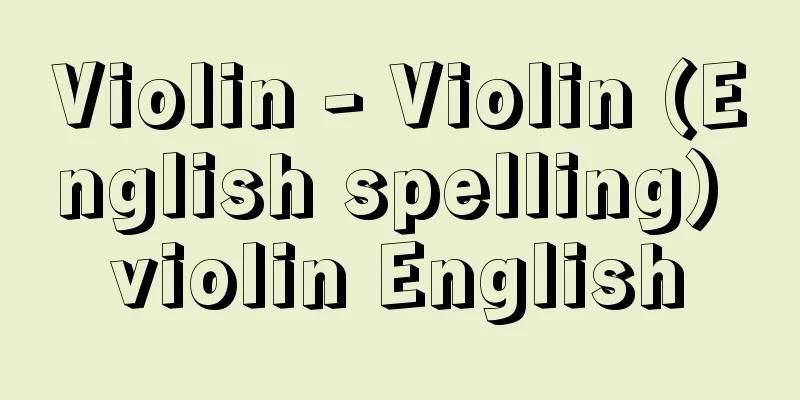Violin - Violin (English spelling) violin English

|
The lute is a bowed string instrument of the violin family, which includes the violin, viola, cello, and double bass. It is a bowed instrument representative of Western music, and plays a central role in orchestral and chamber music due to its wide range and richly variable volume and tone. It is also widely used in folk music. [Yokohara Chishi] historyIt developed from medieval stringed instruments such as the vihuela, rebec, lira da braccio, and fidel, which originated from the ancient Greek instrument kithara and the West Asian reverb, and its prototype was created around 1520. By 1550, it had become almost the same shape as the current four-stringed instrument, and began to spread widely. The first makers of the extant instruments were Andrea Amati (c. 1510-c. 1580) and Gasparo Bertolotti da Salo (1540-1609). After that, it was gradually improved, and the Cremonese masters Antonio Stradivari (1644-1737), Nicola Amati (1596-1684), and Giuseppe Guarneri (1698-1744) perfected it to a perfect form in terms of volume and tone, which would become a model for later generations. In addition to their disciples, many other schools and great makers such as the Guadagnini, Testore and Gagliano schools emerged in Italy, and violin making reached its heyday. In Germany, Mittenwald, led by Jakob Steiner (c. 1617-1683) and Matthias Klotz (1653-1743), and in France, Mirecourt, led by Jean-Baptiste Vuillaum (1798-1835), became the center of violin making. As the demand for volume gradually increased in modern times, the tension of the strings increased, and changes were made to small details such as the length and angle of the neck, the bridge, and the brace, but the body, which is the main resonating part, remained completely unchanged. The bow also became stronger, and the French virtuoso François Tourte (1747-1835) perfected the model shape. There have been no changes since then. Today, these 17th and 18th century instruments are highly valued as masterpieces and are extremely expensive, but they are also highly valued as works of art and antiques. There are many new instruments that are just as good as these famous old instruments. [Yokohara Chishi] structureThe total length is about 60 centimeters, and is divided into the body, neck, strings, bridge, and string stop. The body is a resonating box consisting of a top board, back board, and sides, and determines the quality of the sound. The top board is made of high-quality red fir and pine, while the back board and sides are made of maple. Each board is 1 to 5 millimeters thick and has an intricate curve. Two F-shaped sound holes are drilled symmetrically on the left and right sides of the top board, and the bridge is placed along the horizontal line of the holes. Inside the body, that is, on the bottom of the left and right legs of the bridge, there are braces and a sound post, which not only provide reinforcement but also transmit and equalize vibrations, enriching the bass and treble tones. The oil varnish applied to the surface of each board is sometimes debated for its effect on the tone, but it serves more of an aesthetic purpose and to protect the wood. The neck, together with the box-shaped pegs and the top scroll, is carved from a single piece of maple wood and glued to the body. An ebony fingerboard without frets is attached to the surface, extending to the center of the body. Tapered pegs are inserted into the pegs, and the tension of the strings from the string stop is adjusted by friction. Until the 19th century, gut or gut wrapped in metal was used for the strings, but in recent years, steel strings have become more common. From the right, the strings are called (1) E string, (2) A string, (3) D string, and (4) G string, and are tuned a fifth lower, as follows: E 5 ― A 4 ― D 4 ― G 3. Each string has a different tone. The bridge is made of maple, and its thin plate has a heart-shaped hole and a notch, which allows it to expand and contract just enough to transmit the vibration of the strings to the top plate. If necessary, a mute is inserted into the bridge, which not only suppresses the vibration and creates a mute effect, but also produces a unique tone color. The bow is about 75 centimeters long, with a thin, elastic body made of Pernambico or snakewood, and a hundred or so horsetail hairs are tied together and pulled with a screw to adjust the tension. The roughness of the hairs' surface and the friction caused by the application of rosin create continuous tiny vibrations in the string, which produces sound. In addition to the standard models listed above, there are also small 7/8, 3/4, 1/2, 1/4, and 1/8 sizes for children, as well as silent practice violins. [Yokohara Chishi] Playing techniqueThe playing style and holding method vary depending on the era and region, but the most standard way is to hold the instrument horizontally between the chin and the left collarbone. The left hand is allowed to move freely over the strings. Using the index finger as a reference, the shape of each finger is decided according to the notes of the scale, and the position is changed by shifting the index finger. The positions are called 1st, 2nd, etc. from the farthest, and usually up to the 7th position is used. In this way, a wide range of notes close to five octaves from G3 to E8 is obtained. The notes are produced using the four fingers excluding the thumb, and characteristic techniques include vibrato, which adds subtle nuance to the tone by vibrating the fingers, flageolet, which produces octave or higher overtones by lightly pressing the strings, and portamento, which smoothly changes leap intervals. The right hand holds the hair of the bow lightly, and the wrist is flexible as the bow moves. The bow is placed on the string between the bridge and the gap in the fingerboard, and the pressure is adjusted with the fingers. The closer the bow is to the bridge, the harder the tone becomes. This bow manipulation allows for a wide variety of expressions, from smooth legato to crisp staccato, fine tremolo, and strong accents. Special bowing techniques include spiccato, which uses the elasticity of the bow to make the bow jump and produce fine sounds, sul ponticello, which is played at the bridge, and col legno, which is struck with the bow. In addition, a wide variety of tones is possible using a variety of techniques, such as polyphony, which involves playing two or more strings at the same time to produce chords; pizzicato, which involves plucking the strings with the fingers; con sordino, which involves using a mute to produce a nasal tone, and scordatura, which involves changing the normal tuning. [Yokohara Chishi] Music and performersThe violin, which was born in the early 16th century, was not as popular as the viol, which was in vogue at the time. It was considered an instrument that produced a loud, unrefined sound, and because it was tuned in fifths, it was used by lower-ranking musicians to accompany dances for long periods. However, musical tastes gradually changed, and with the use of the violin in Monteverdi's opera Orfeo (1607) and the appearance of the first great performer and composer, Biagio Marini (c. 1597-1665), the violin gradually began to be used in ensembles. Corelli was the decisive force in this trend, as he compiled the sonatas that had been produced up to that point. Under their influence, many composers, including Vivaldi, who composed the Concerto Grosso, PA Locatelli (1695-1764), who used the 14th position, FS Geminiani (1687-1762), who also wrote excellent didactic books, T. Albinoni (1671-1750), G. Tartini (1692-1770), and others, created the Golden Age of violin music. This coincided with the heyday of instrument making. Their works established the importance of the violin in ensembles and at the same time paved the way for the solo concerto. This was the extension of the concertos of J.S. Bach, Handel, Telemann, Mozart, and others. In Germany, Heinrich Ignaz Franz von Biber (1644-1704) and Johan Jakob Walther (c. 1650-1717) wrote polyphonic sonatas using the irregular tuning method of scordatura, and J.S. Bach perfected this tradition artistically with his Sonatas and Partitas for Solo Violin (c. 1720). This sonata tradition was transformed into the trio sonatas of C.P.E. Bach and Stamitz, and developed into the violin sonatas of Mozart and Beethoven. With the improvement of bows at the end of the 18th century, GB Viotti (1755-1824) established the modern playing style, and the schools of his pupils, virtuoso performers and educators Rodolphe Kreutzer (1766-1831), Pierre MF d. S. Baillot (1771-1842), and Pierre Rode (1774-1830), continue to this day. In addition, Paganini took the world by storm with his overwhelming virtuosity, and after that, virtuosos who were independent of composers began to compete with each other for virtuosity. This trend has continued through composers such as Henry Vieuxtemps (1820-1881), Sarasate, Joseph Joachim (1831-1907) who worked to popularize German classical music, Eugène Auguste Ysaÿe (1858-1931) who influenced French composers, Leopord Auer (1845-1930) and Carl Fresch (1873-1944) who were also great educators, and has continued to modern virtuoso such as Herman, Thibaut, Busch, Kreisler, Szighetti, Heifetz, and Oistrakh. It can be said that the efforts of these virtuoso and educators have steadily raised the average level of various techniques that produce diverse and rich tones, accurate pitch, intonation, and more, including vibrato and flexible bowing techniques. The Romantic concertos are where this virtuosity is most fully displayed, and many masterpieces were created by Beethoven, Mendelssohn, Brahms, Lalo, Saint-Saëns, Biniawski, Tchaikovsky, Dvorak, Sibelius, and others. The sophistication of the technique spread to the violin part of symphonies, orchestral works, and chamber music, and its importance increased. In the case of sonatas, works by Brahms, Grieg, Franck, and Faure, after Beethoven, are famous as masterpieces. In the first half of the 20th century, Reger, Hindemith, Stravinsky, Prokofiev, Schoenberg, Berg, Shostakovich and others wrote concertos, but in modern times, the frequency of using the violin in new works has decreased, and performers have shifted their focus to recreating classical music. In recent years, music from before the 18th century is often performed using old or baroque violins with gut strings and weak tension. [Yokohara Chishi] The violin in folk musicDue to its excellent qualities such as loudness and variety of tones, the violin is widely used not only in Western art music but also in folk music around the world. In general, it has replaced indigenous traditional instruments due to its characteristics, and is used mainly to accompany folk dances and songs, and in folk instrument ensembles, sometimes with ethnic modifications. It is often held against the chest and supported by the left hand rather than held under the chin, and there is little movement in position. In Europe, it was introduced to Northern Europe in the 17th century, and by the early 18th century it had spread throughout Europe. In these instruments, the open strings are often used as sustaining notes, and the other strings are used to play the melody. Characteristic uses include the gypsy ensembles of southern and eastern Europe, the mazanki, an instrument with high frets in Poland, the irregular tuning method scordatura and free-tempered music doina in Romania and Moldavia, and the double-tone melisma in the Baltic countries. Outside of Europe, the instrument was mainly introduced by Portuguese missionaries and merchants in colonies, and it became widespread from the end of the 18th century. In Asia, especially in South India, it was adopted early on as a vocal accompaniment and solo instrument in classical art music. The player sits cross-legged, places the instrument's volute against the right foot, and presses the string against the chest, freeing the left hand to play complex ornamental forms over a wide range of tones. Other distinctive features include Turkish and North African instruments held vertically, and Malay court dances in which the instrument is played in ensemble with ethnic instruments. In North America, British players maintain traditional playing methods and have a repertoire of over 1,000 pieces, while players of country and western origin have created their own unique rhythmic style, and black players in the south have developed their own style and rhythm. The latter's lively style has also influenced Mexican ensembles. Variations of the instrument include the balsa violin in Peru and the bamboo violin in Jamaica. [Yokohara Chishi] "Famous Violins" by Franz Falga, translated by Sasaki Yoichi (1960, Ongaku No Tomo Sha)" ▽ "Violin" by Marc Pencher, translated by Okubo Kazuo (Hakusuisha, Que sais-je Bunko)" ▽ "Famous Violins" by Watanabe Kyozo (1984, Ongaku No Tomo Sha)" ▽ "The Devil's Violin" by Sasaki Yoichi (1982, Ongaku No Tomo Sha)" ▽ "The Charm and Mystery of the Violin" by Sasaki Yoichi (1987, Ongaku No Tomo Sha)" ▽ "Famous Violinists of the 20th Century" by Joachim Hartnack, translated by Matsumoto Michisuke (1971, Hakusuisha) [References] | | |©Yamaha "> violin ©Shogakukan "> Names of the violin's parts and internal structure "Francesca" by Stradivari. 1694, wood, length 58.4cm, owned by the Metropolitan Museum of Art, Italy. Violin (Stradivarius) Source: Shogakukan Encyclopedia Nipponica About Encyclopedia Nipponica Information | Legend |
|
リュート属擦弦楽器。バイオリン、ビオラ、チェロ、コントラバスからなるバイオリン族の高音楽器。西洋音楽を代表する弓奏楽器で、幅広い音域と豊かに変化する音量・音色によって管弦楽や室内楽で中心的役割を担っている。また、民族音楽でも広く用いられる。 [横原千史] 歴史古代ギリシアの楽器キタラや西アジアのレバーブなどを起源とする中世の弦楽器ビウエラ、レベック、リラ・ダ・ブラッチョ、フィーデルから発展し、1520年ころその原型が生まれた。1550年ころには4弦の、現在とほぼ同形となり、広く普及し始める。現存する楽器の最初の製作者はA・アマーティAndrea Amati(1510ころ―1580ころ)、ダ・サロGasparo Bertolotti da Salo(1540―1609)である。その後すこしずつ改良が加えられ、ストラディバリAntonio Stradivari(1644―1737)やN・アマーティNicola Amati(1596―1684)、グアルネリGiuseppe Guarneri(1698―1744)らクレモナの巨匠たちによって音量・音色ともに後世の模範となる完璧(かんぺき)な形に仕上げられた。彼らの弟子たちのほかに、イタリアではガダニーニ派、テストーレ派、ガリアーノ派など多くの流派と名作者が生まれ、バイオリン製作の最盛期を迎えた。ドイツではシュタイナーJakob Steiner(1617ころ―1683)、クロッツMatthias Klotz(1653―1743)らのミッテンワルト、フランスではビヨームJean-Baptiste Vuillaum(1798―1835)らのミルクールが製作の中心地となった。 近代に入ってしだいに音量への要求が高まるにつれて、弦の張力が増し、棹(さお)の長さ・角度、駒(こま)、力木(ちからぎ)など細かな点に変更が加えられたが、おもな共鳴部分である胴はまったく変わらなかった。弓も同様に張りの強いものに変わっていき、フランスのトゥールトFrançois Tourte(1747―1835)が模範的な形を完成させた。以後、変化はない。 現代ではこれら17、18世紀の楽器が名器として珍重され、きわめて高価なものとなっているが、それらには美術品的、骨董品(こっとうひん)的な価値も多分に付与されている。新作でも古名器に劣らぬ楽器も少なくない。 [横原千史] 構造全長は約60センチメートルで、胴・棹・弦・駒・緒止(おどめ)の各部分に分かれる。胴は表(おもて)板・裏(うら)板・横板からなる共鳴箱で、音のよしあしを左右する。表板にはアカモミ、マツ、裏板と横板にはカエデの良質な材料が吟味され、各板とも厚さ1~5ミリメートルで精巧な湾曲がつくりだされる。表板には左右対称に二つのf字型響孔があけられ、その横線にあわせて駒が置かれる。胴内部、つまり駒の左右の足の裏側にはそれぞれ力木と魂柱(こんちゅう)が取り付けられ、これらは単なる補強だけでなく振動の伝達・均一化の役割をもち、低音・高音の音色を豊かにしている。各板の表面に塗られた油ワニスは音色への影響が議論されることもあるが、美観と木材の保護の役割のほうが大きい。 棹は、糸巻のある箱型にくりぬかれた糸蔵(いとぐら)、上部の渦巻とともに1本のカエデ材から削り出され、胴に接着される。表面には黒檀(こくたん)製でフレットのない指板が胴中央部までせり出してつけられる。糸蔵にはテーパー状の糸巻が差し込まれ、緒止からの弦の張力を摩擦で止めながら調節する。 弦は19世紀までガット(羊腸)またはガットに金属を巻いたものが使われたが、近年ではスチール製のものが多用される。右から、(1)E線、(2)A線、(3)D線、(4)G線とよばれ、5度ずつ低くE5―A4―D4―G3と調弦される。各弦はそれぞれ異なる音色をもつ。 駒はカエデ製で、その薄板にはハート形の穴と切れ込みが入っており、これによって適度の伸縮が生まれ、弦の振動を表板に伝える。必要に応じて駒に弱音器を差し込むが、これは振動を抑制して弱音効果を生むだけでなく、異質な音色を生み出す。 弓は約75センチメートルで、ペルナンビーコやスネークウッド製の細く弾力がある弓身に、馬の尾の毛百数十本を束ね、ねじで張力を加減しながら引き付ける。毛の表面の粗さと松脂(まつやに)の塗布による摩擦によって弦が連続微小振動をおこし、発音する。 以上の標準的な型のほかに、子供用の7/8、3/4、1/2、1/4、1/8の小型のものや、練習用無音バイオリンもある。 [横原千史] 奏法奏法や構え方は時代、地域によりさまざまである。もっとも標準的な構え方は、あごと左鎖骨で挟み、楽器を水平に支える方法である。 左手はまったく自由に弦上を動くようにする。人差し指を基準として、音階構成音に従って各指を押さえる形を決め、人差し指をずらすことでポジションを変える。ポジションは遠いほうから順に第1、第2、……とよばれ、通常第7ポジションまで用いられる。こうしてG3―E8の5オクターブに近い広い音域が得られる。音を奏するには親指を除く4指を用いるが、その特徴的な技法としては、指を震わせて音色に微妙なニュアンスを加えるビブラート、軽く押さえることによってオクターブあるいはそれ以上の倍音を出すフラジョレット、跳躍音程を滑らかに移すポルタメントなどがある。 右手は弓身の毛止めの部分を軽く持ち、手首をしなやかにして弓を動かす。弓は駒と指板の切れ目の中間の弦上に置き、指で圧力を加減する。その際、音色は駒に近づくほど硬くなる。この弓の操作によって、滑らかなレガートから、歯切れのよいスタッカート、細かいトレモロ、強いアクセントに至るまで多様な表現が可能となる。特殊な運弓法に、弓の弾力性を利用し、弓を跳躍させて細かい音を出すスピッカート、駒のところで弾くスル・ポンティチェッロ、弓身で弦をたたくコル・レーニョなどがある。 このほか、2本以上の弦を同時に鳴らして和音を出す重音奏法、弦を指ではじくピッチカート、弱音器で鼻にかかったような音色にするコン・ソルディーノ、正規の調弦を変えるスコルダトゥーラなど、さまざまな技法で多彩な音色が可能となる。 [横原千史] 音楽と演奏家16世紀初頭に生まれたバイオリンは当時流行していたビオールほど人気がなく、品のない大きな音を出す楽器とされ、5度調弦の特性から、長く舞踊を伴奏する下級楽士の楽器であった。しかし音楽の嗜好(しこう)がしだいに変化し、モンテベルディのオペラ『オルフェオ』(1607)におけるバイオリンの使用、最初の大演奏家兼作曲家マリーニBiagio Marini(1597ころ―1665)の登場を契機として、しだいに合奏のなかで用いられるようになる。この傾向を決定的にしたのがコレッリで、彼はそれまでのソナタを集大成した。その影響下に、合奏協奏曲のビバルディをはじめ、第14ポジションまで駆使したロカテッリP. A. Locatelli(1695―1764)、優れた教則本の作者でもあったジェミニアーニF. S. Geminiani(1687―1762)、アルビノーニT. Albinoni(1671―1750)、タルティーニG. Tartini(1692―1770)ら多くの作曲家がバイオリン音楽の黄金時代を築いた。これはまさに楽器製作の最盛期と一致する。彼らの作品によって合奏におけるバイオリンの重要性が決定づけられ、同時に独奏協奏曲への道が開かれた。この延長線上にJ・S・バッハ、ヘンデル、テレマン、モーツァルトらの協奏曲が生まれる。 ドイツではビーバーHeinrich Ignaz Franz von Biber(1644―1704)、ワルターJohan Jakob Walther(1650ころ―1717)らが変則的な調弦法スコルダトゥーラを用いて多声ソナタを書き、その伝統のうえにJ・S・バッハが『無伴奏バイオリン・ソナタとパルティータ』(1720ころ)で芸術的に完成させた。このようなソナタの伝統はC・P・E・バッハ、シュターミッツらのトリオ・ソナタへと変容していき、モーツァルト、ベートーベンのバイオリン・ソナタへと発展してゆく。 18世紀末の弓の改良とともにビオッティG. B. Viotti(1755―1824)が近代奏法を確立し、その弟子で名演奏家兼教育家のクロイツェルRodolphe Kreutzer(1766―1831)、バイヨPierre M. F. d. S. Baillot(1771―1842)、ロードPierre Rode(1774―1830)の流派は現代にまで及ぶ。またパガニーニが圧倒的名人芸で世界を席巻(せっけん)し、以後、作曲家から独立したビルトゥオーゾたちが名技性を競うようになる。それは、作曲家でもあったビュータンHenry Vieuxtemps(1820―1881)、サラサーテ、ドイツ古典の普及に努めたヨアヒムJoseph Joachim(1831―1907)、フランスの作曲家に影響を与えたイザイEugène Auguste Ysaÿe(1858―1931)、偉大な教育者でもあったアウアーLeopord Auer(1845―1930)、フレッシュCarl Fresch(1873―1944)を経て、エルマン、チボー、ブッシュ、クライスラー、シゲッティ、ハイフェッツ、オイストラフと現代の名手まで脈々と続く傾向である。これらの名手、教育家の努力により、ビブラートや柔軟な運弓法をはじめ、多様で豊かな音色、正確な音程、イントネーションなどを生み出すさまざまな技法の平均水準が確実に高められたといえよう。 このような名人芸が最高度に発揮されるのがロマン派の協奏曲であり、ベートーベン、メンデルスゾーン、ブラームス、ラロ、サン・サーンス、ビニヤフスキ、チャイコフスキー、ドボルザーク、シベリウスらによって多くの名曲が生み出された。技巧の洗練度は交響曲、管弦楽曲、室内楽曲のバイオリン・パートにも波及し、ますますその重要性を強めることとなる。ソナタではベートーベン以降、ブラームス、グリーグ、フランク、フォーレらの作品が傑作として名高い。 20世紀前半にはレーガー、ヒンデミット、ストラビンスキー、プロコフィエフ、シェーンベルク、ベルク、ショスタコビチらが協奏曲を書いているが、現代の全般的な傾向としては新作におけるバイオリンの使用頻度はかつてより減少し、むしろ古典の再現に演奏家の重点は移っているといえる。また近年、18世紀以前の音楽については、ガット弦で張力の弱いオールドまたはバロック・バイオリンを用いて演奏されることも多い。 [横原千史] 民族音楽におけるバイオリンバイオリンはその音量の大きさ、音色の多彩さなどの優れた特質によって、西洋芸術音楽のみならず、広く世界の民族音楽にも普及している。一般にその特性から土着の伝統楽器にとってかわり、ときには民族的変形を伴いながら、主として民族舞踊や民謡の伴奏、民族楽器のアンサンブルに用いられる。構え方は、あごで挟むよりも胸に当てて左手で支えることが多く、ポジション移動は少ない。ヨーロッパでは17世紀に北欧に入り、18世紀初頭にはヨーロッパ全体に浸透した。それらにおいては、開放弦を持続音とし、他の弦で旋律を奏することが多い。特徴的な用法としては、南欧・東欧のジプシー・アンサンブル、ポーランドの高音域のフレットをもつ楽器マザンキ、ルーマニアやモルダビアの変則的調弦法スコルダトゥーラと自由律音楽ドイナ、バルト諸国の重音メリスマなどがある。 ヨーロッパ以外へはおもにポルトガル人宣教師や商人が植民地で広め、18世紀の終わりごろから普及していった。アジアのなかでもとくに南インドでは、古典芸術音楽の声楽伴奏や独奏の楽器として早くから取り入れられた。あぐらをかき、右足に楽器の渦巻を当てて緒止(おどめ)掛けを胸に押し付ける独特の構えで左手を自由にし、広い音程に及ぶ複雑な装飾音形などを奏する。このほか、垂直に立てて構えるトルコや北アフリカ、民族楽器と合奏するマレー宮廷舞踊が特徴的である。北アメリカではイギリス系の奏者が伝統的奏法を守り、1000曲以上のレパートリーをもつ一方、カントリー・アンド・ウェスタンのなかで独自のリズミカルな様式を生み出したり、南部の黒人系奏者が独自のスタイルやリズムを打ち出したりしている。後者の活発な様式はメキシコのアンサンブルにも影響を与えている。楽器の変形例としてはペルーのバルサフィードル、ジャマイカの竹バイオリンなどがある。 [横原千史] 『フランツ・ファルガ著、佐々木庸一訳『ヴァイオリンの名器』(1960・音楽之友社)』▽『マルク・パンシェル著、大久保和郎訳『ヴァイオリン』(白水社・文庫クセジュ)』▽『渡辺恭三著『ヴァイオリンの銘器』(1984・音楽之友社)』▽『佐々木庸一著『魔のヴァイオリン』(1982・音楽之友社)』▽『佐々木庸一著『ヴァイオリンの魅力と謎』(1987・音楽之友社)』▽『ヨアヒム・ハルトナック著、松本道介訳『二十世紀の名ヴァイオリニスト』(1971・白水社)』 [参照項目] | | |©ヤマハ"> バイオリン ©Shogakukan"> バイオリンの各部名称と内部構造 ストラディバリ作『フランチェスカ』。1694年 木 全長58.4cm イタリアメトロポリタン美術館所蔵"> バイオリン(ストラディバリウス) 出典 小学館 日本大百科全書(ニッポニカ)日本大百科全書(ニッポニカ)について 情報 | 凡例 |
<<: Violet - Violet (English spelling) sweet violet
>>: Biorhythm - Biorhythm (English spelling)
Recommend
Trousers
… refers to trousers worn alone, not as trousers ...
Mount Arafune
A volcano in the southwest of Gunma Prefecture, b...
Lower Canada
The old name of the Canadian province of Quebec. I...
Aonotsugazakura - Aonotsugazakura
→ Tsugazakura Source : Heibonsha Encyclopedia Abou...
Yabudemaris - Yabudemaris
A deciduous shrub or small tree of the Caprifolia...
Short-run cost, long-run cost
The most important concepts of time in economics a...
Contact metamorphism
This is a metamorphism in which rocks change due t...
Xenops minutes
...They live in trees and forests, building nests...
Friend - Nakama
1. A relationship in which you do things together....
Clough, Arthur Hugh
Born: January 1, 1819, Liverpool [died] November 1...
Reverse image
…In particular, f ( A ) is called the image of f ...
Isemachi Rice Exchange - Isemachi Rice Exchange
…He established the Sankyo Kaisho in 1809 (Bunka ...
Record of the Great and Small Mind - Tandaishoshinroku
A collection of essays by Ueda Akinari. Published...
Watts, C.
...Mick Jagger (1943- ), Keith Richards (1943- ),...
Weaver, W.
Machine translation is a method of translating a ...









